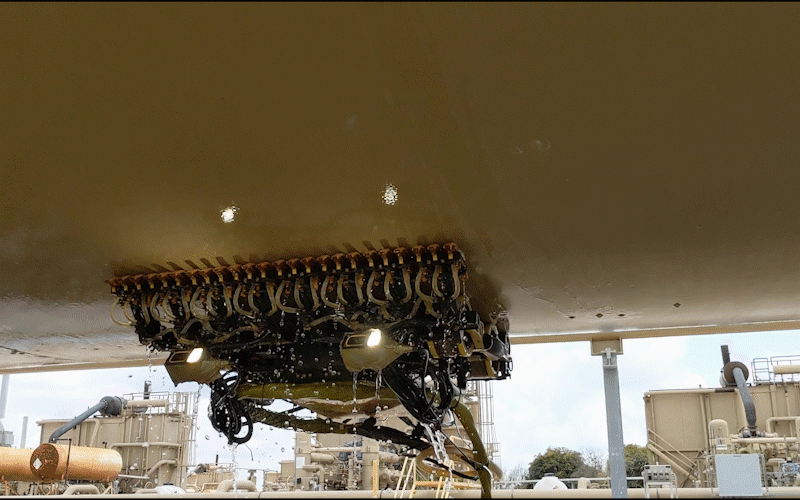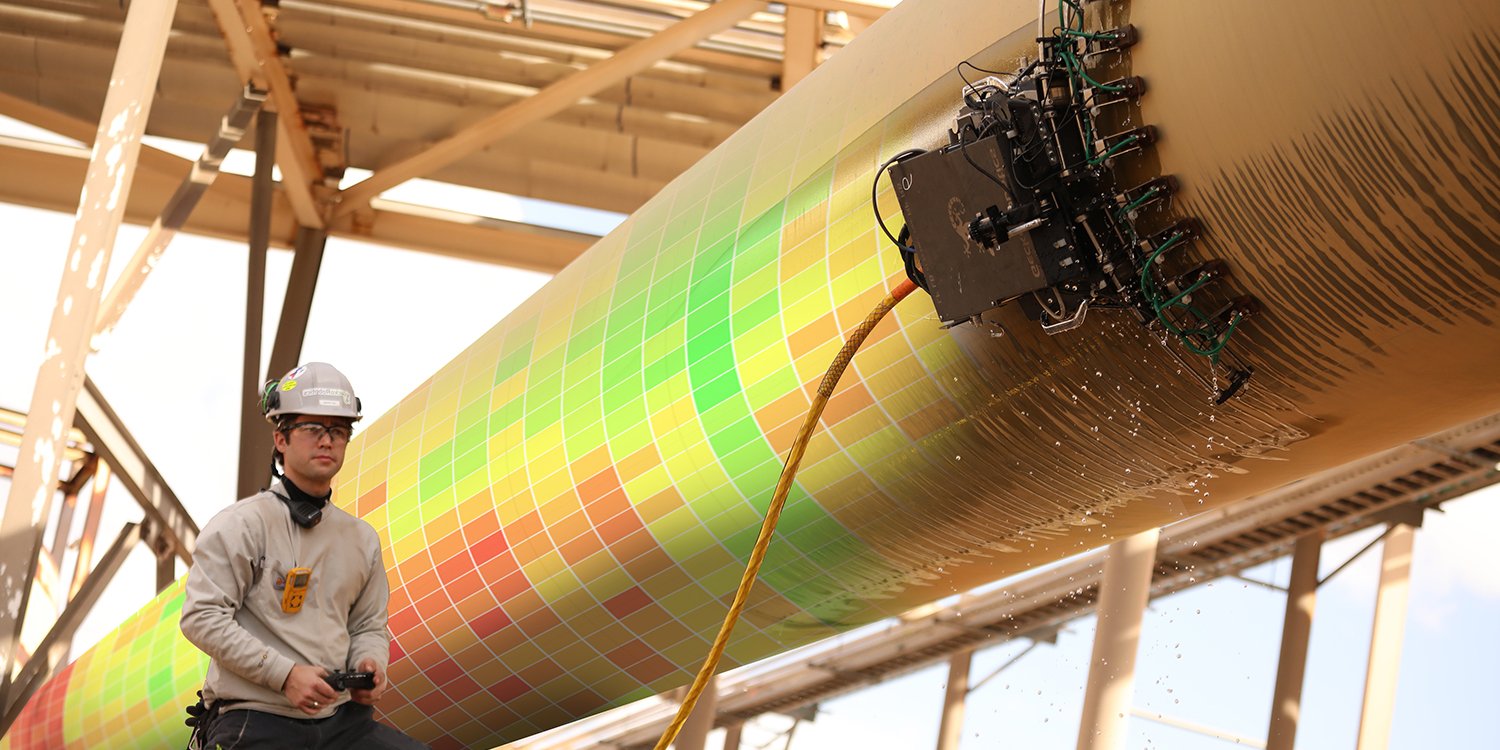We are witnessing an inflection point in the approach to inspecting piping assets in the oil and gas industry, as well as other process industries. In wake of the COVID-19 pandemic, companies are looking to achieve the same reliability while reducing on-site human exposure. Granted robotic inspections certainly present less human contact, yet these companies are realizing additional benefits they might not have expected. Gecko’s fast inspection technique, known as RUG, is tailor-made for long linear sections of piping that need complete coverage. Here are the reasons why companies have come to depend on the technique.
Safety is Everybody's Business
One of the biggest impacts on improving safety is the ability to keep inspectors out of dangerous environments or situations. Traditional/Manual inspection requires physical access for every portion of the piping being inspected. Getting to the piping often requires rope access or working on scaffolding for extended periods of time. Adverse conditions can also pose a potentially hazardous condition for inspectors.
Automated and robotic inspection methods require significantly less time spent working at heights and much less movement when elevated access to piping runs is required. Minimizing movement at elevated heights is one way to improve safety, as each movement carries a risk of mechanical failure for scaffolding, rope access, or boom lift machinery. Due to the linear nature of piping, many such movements are needed. What’s more, Robots are capable of entering areas that have not been cleared for human accessibility.
The ability to conduct inspections on piping assets without requiring plant shutdown allows the plant to fulfill its safety obligations while continuing to make money. However, exposing inspection personnel to environments and surfaces with dangerous temperatures adds excessive risk. To counter that, Gecko created the TOKA 3 HotBot, featured in this case study. The TOKA 3 HotBot is specifically designed for inspections of assets with surface temperatures up to 250º F. This technological advancement allows the NDT Inspector to capture inspection data while maintaining a safe distance from the online pipe until the inspection is completed and the robot is ready to be removed.
Saving Time and Money
Inspection speed saves time; time is money, so Rapid Ultrasonic Gridding (RUG) with robotic platforms saves time and money. Pretty simple, right. But, to better understand speed as a differentiating factor for RUG, let’s take a look at the three primary inspection methods in those terms.

Manual Inspections are slow and inefficient. Gridding the asset by hand is tedious and time consuming. Manual sampling is imprecise and unlikely to find the most critical areas on the pipe. The inspector spends a significant amount of time collecting a small amount of inspection data using a single transducer. The inspection speed of manual inspection is further impacted by raised elevations, where scaffolding or rope access must be put into place before an inspection can begin. Not to mention, piping runs can extend to hundreds and thousands of feet in length.
Automatic Ultrasonic Testing (AUT) gathers a massive volume of data for the asset. However, it is able to accomplish this primarily because of its slower speed of operation. And, while too little data leads to uncertainty, sometimes huge amounts of data can actually slow down your analysis, causing delays in your remediation plan.
For piping, RUG provides 1000 times more data than manual inspection. Enough said.
In comparing AUT and RUG inspection speeds for pipelines and similarly shaped tanks, RUG can complete the inspection at speeds of 60 feet per minute. This is, on average, 7 to 10 times faster than speeds delivered by leading AUT inspection companies.

RUG’s faster inspection times lead to reduced onsite time by inspection personnel. In fact, robotic inspections can result in a 50% reduction in staff requirements compared to AUT inspections. On a recent inspection of a fractionator overhead line, featuring the TOKA 3 HotBot, Gecko’s robotic inspection reduced costs by 66% over AUT. This reduced cost comes from smaller inspection teams and faster inspection, aided by the industry’s fastest feet-per-minute crawling speed.
It's not the Robot. It's the Software.
That may be a strange statement to make, coming from a company whose name includes “Robotics.” In fact, Gecko does not sell robots. Our robots merely serve as the tools that capture the data that enables us to provide an interactive view of your assets through our proprietary software. We are, in essence, an NDT Inspection and Software as a Service (SaaS) company with a RaaS (Robot as a Service) component on the front end.

Rich, Smart, Interactive Data
The RUG inspection rapidly captures up to 176 readings per foot at a maximum speed of 60 feet per minute. In a short amount of time, millions of A-scan data points are compiled within digital grid maps of your piping. Our software processes and presents this data to you as downloadable C-scan imagery. When a small team can collect over a million thickness readings, across hundreds of feet of pipe, in a single shift, it becomes essential for new tools to be developed to realize the value of the data.
Through your Gecko Customer Portal, you are able to access and manipulate those views in 2D or 3D perspectives from any device. You’ll see that grids are intuitively color-coded to enable you to easily recognize relative thin areas in the asset’s wall thickness. You are quickly able to see areas of piping that need attention, based on customizable thickness thresholds as determined by your RBI program. Massive amounts of data are captured and stored and can easily be analyzed and compared to past inspections (including inspections by other methods) to determine the trending health of assets.
Confidence is a Team Sport
Yes, our robots are adorned with the latest technological advancements possible, but it is a team sport to collect and process the data needed to deliver insights. We pride ourselves on professionalism and experience throughout the inspection process from the first safety briefing until the final report.
Gecko Robots are operated by our own Level II and Level III inspection teams. Our inspectors have years of experience in piping and other assets. They’ve been there, done that. You are able to utilize fast, incredibly accurate, and actionable robotic inspection without having to invest in your own robot, or in having a trained robot operator on your staff.
The Leading Edge of Piping Inspection Technology

Process industries are quickly recognizing the benefit of Rapid Ultrasonic Gridding for their piping assets. They see the significant value that comes from faster inspection speeds, richer data, the ability to interact with that data through an online portal, and the increased safety for inspection personnel. Where, Manual Inspection, and to some extent AUT, tends to lead to reactive maintenance activity, RUG enables plant management to do proactive maintenance and repair planning, resulting in shorter shutdowns and increased asset productivity.
Simply put, Rapid Ultrasonic Gridding as provided by Gecko Robotics is the leading edge of piping inspection technology.

